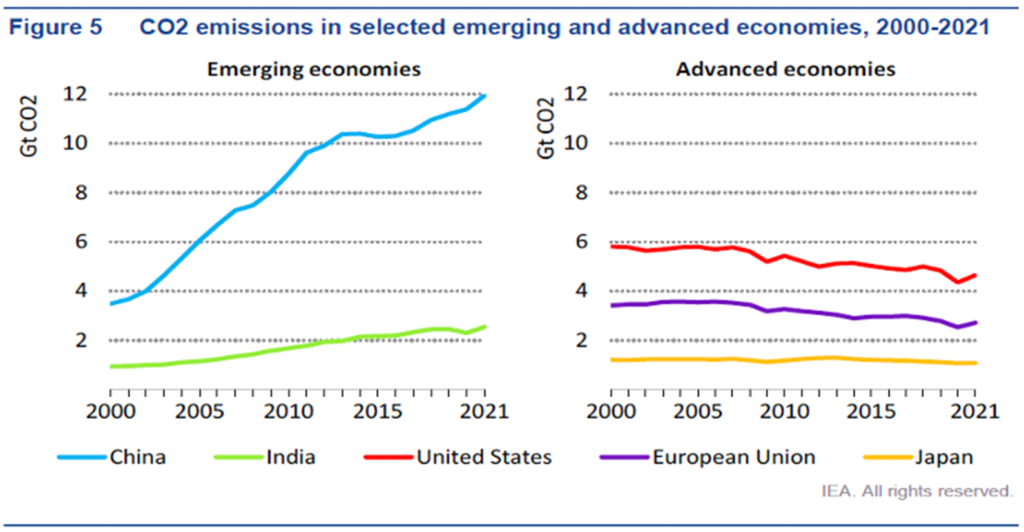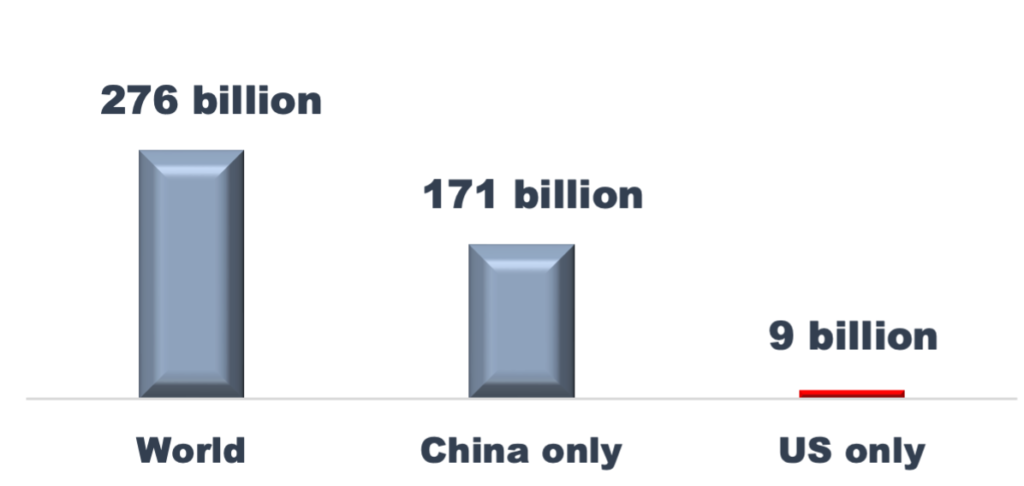The Biden administration continues to pursue its decarbonization goals, while other countries increase their reliance on coal because of its affordability and abundance.[i] China – the world’s largest carbon emitter – pledged to stop increasing its carbon emissions “before 2030.” In addition, President Xi Jinping pledged to “strictly control” coal consumption until 2025 and start cutting coal use in 2026 in order to reach maximum CO2 emissions by China before 2030.
This short paper provides some quick facts, mostly about China, which we thought readers might find interesting.[ii] However, keep in mind that India has the world’s second largest coal fleet (233,000 MW plus 57,000 MW being built or under development) which is much larger than the U.S. coal fleet (200,000 MW).
China’s coal fleet is enormous and growing.
- China has the world’s largest coal fleet totaling 1.074 million megawatts (MW) of coal-fired generation capacity. This is half the world’s coal fleet (2.067 million MW) and almost the same size as the entire U.S. electricity supply (1.15 million MW of natural gas, coal, nuclear, renewables, etc.).
- The chart below shows the number of coal plants in (1) China, (2) the rest of the world minus China and the U.S., and (3) the U.S. The world coal fleet (excluding the U.S.) is already 10 times larger (2,214 plants) than the U.S. fleet (225 plants), and the world fleet is growing while the U.S. fleet is shrinking.
Existing Coal Plants

- China has added almost 580,000 MW to its coal fleet since 2010, while the U.S. retired approximately 100,000 MW of coal over the same period. In other words, China added almost 6 times more new coal generating capacity during 2010-2022 than the U.S. retired over the same period.
- Worldwide, slightly more than 476,000 MW of coal-fired generation are under construction or in various stages of development. China has more than 290,000 MW of this total. For perspective, the existing U.S. coal fleet totals roughly 200,000 MW, but 93,000 MW have announced plans to retire by 2030. Also, EPA regulations are expected to increase coal retirements, especially during 2026-2028.[iii]
- If China adds to its fleet all the coal under construction or development, the Chinese fleet will total 1.36 million MW. So by the end of this decade, China’s fleet could be 14 times the size of the U.S. fleet (taking into consideration announced retirements and those likely to be caused by EPA regulations).
- Also, China has financed more than 39,000 MW of coal projects in other countries since 2015.
China’s emissions have been increasing.
- The chart below shows that China’s CO2 emissions (light blue line) last year had almost quadrupled since 2000. By contrast, U.S. emissions (red line) had declined over the same period.
CO2 Emissions 2000-2021 (billions of tonnes)

- China is the world’s largest emitter of energy-related CO2 emissions at 12.86 billion tonnes last year, slightly more than 30% of global emissions. The U.S. was second at 5.21 billion tonnes, slightly less than 13% of global emissions.
- China’s CO2 emissions increased by 750 million tonnes between 2019 and 2021. China’s increase counteracted a reduction of 716 million tonnes by the rest of the world during the same time period.
- The chart below shows estimated future lifetime CO2 emissions from (1) the current world coal fleet (276 billion tonnes, including China and the U.S.), (2) China’s fleet (171 billion tonnes) and (3) the U.S. fleet (only 9 billion tonnes).[iv] (India’s lifetime CO2 emissions are 35.4 billion tonnes from its existing coal fleet plus coal under construction or development.) Emissions from the coal fleets of China and other countries represent 97% of future CO2 emissions from the world’s coal fleets; the U.S. represents 3%.
Lifetime CO2 Emissions (tonnes)

China’s coal consumption is also increasing.
- China accounted for 52% (4.13 billion tonnes) of the world’s total coal consumption (7.91 billion tonnes) in 2021 and is projected to increase consumption an additional 136 million tonnes by 2024. U.S. coal consumption was 508 million tonnes in 2021.
- By 2024, China’s coal consumption (4.27 billion tonnes) is projected to be 10 times greater than U.S. coal consumption (431 million tonnes).
- China’s 14th Five-Year Plan (March 2021) promotes coal production as a way to enhance the country’s energy security.
[i] The Biden administration has goals of reducing U.S. greenhouse gas emissions by 50-52% in 2030, achieving zero-carbon electricity by 2035, and reducing economy-wide emissions to net zero by 2050.
[ii] Data and other information in this paper are taken from Global Coal Plant Tracker, July 2022; Climate Action Tracker, October 2022; Energy Information Administration 2022 Annual Energy Outlook; International Energy Agency (IEA) Coal 2021 – Analysis and forecast to 2024, December 2021; IEA Global Energy Review: CO2 Emissions in 2021, March 2022; CNN, November 3, 2021; Boston University Global Development Policy Center, China’s Global Power Database, accessed December 14, 2022; Associated Press, “China promotes coal in setback for efforts to cut emissions,” April 25, 2022; and a data base that tracks announced U.S coal retirements.
[iii] Six EPA regulations are expected to have a major impact on the U.S. coal fleet: Coal Combustion Residuals Rule, Effluent Limitations Guidelines, Ozone Transport Rule, ACE replacement rule, Regional Haze Rule, and possibly revised Mercury and Air Toxics Standards. EPA estimates that its proposed Ozone Transport Rule will cause the retirement of 23,000 MW of coal-fired generation by 2025. There are no retirement estimate yet for the other rules.
[iv] Emission projections are from Global Plant Tracker, July 2022. The projections assume a 40-year life span for coal plants. For plants already older than 40 years, 5 more years of operation are assumed.
